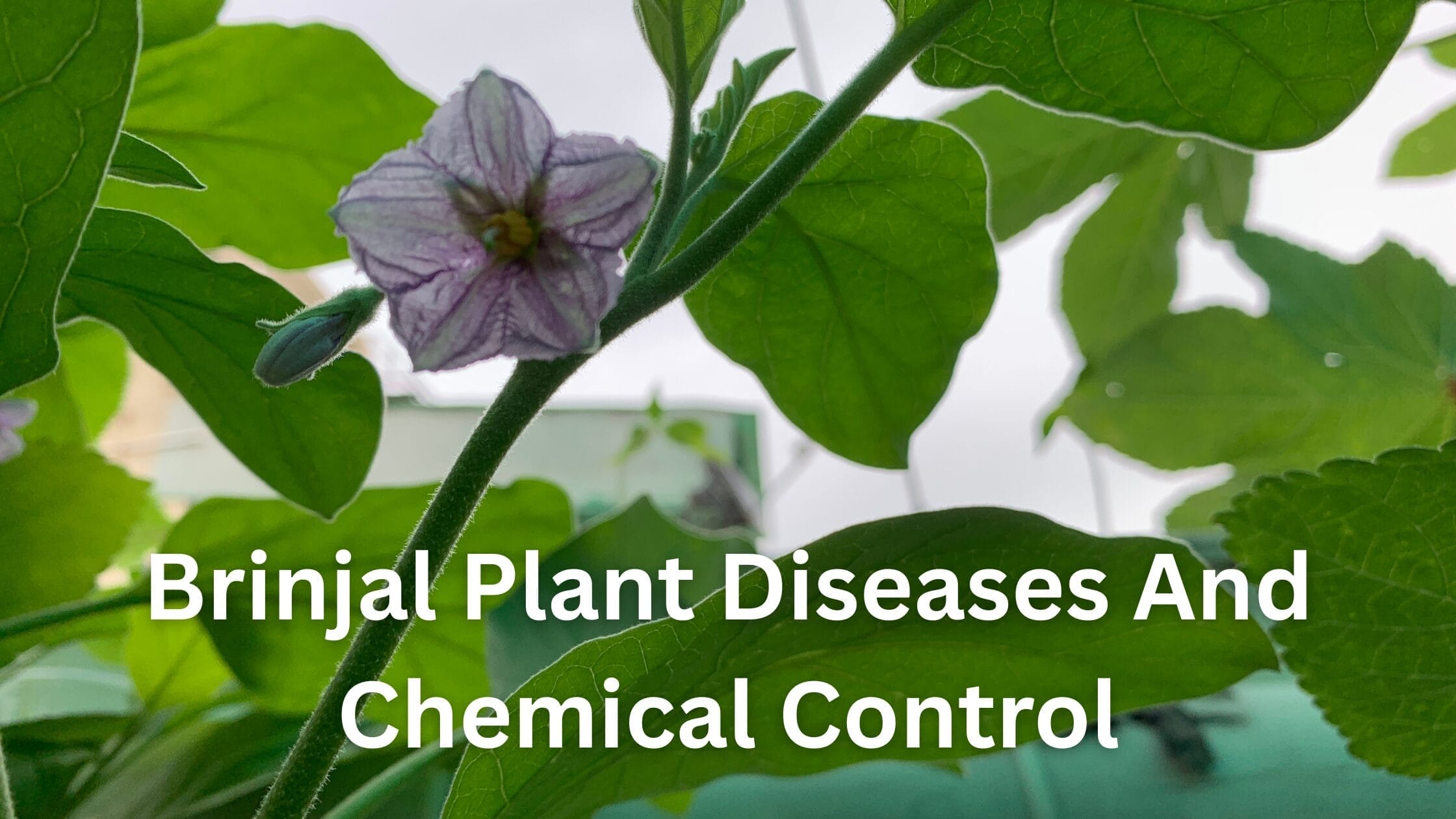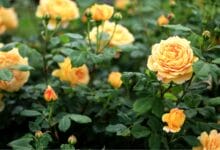Brinjal Plant Diseases and Their Control: A Farmer’s Guide.

Brinjal, also known as eggplant, is one of the most widely cultivated vegetables across tropical and subtropical regions. However, brinjal plants are vulnerable to several diseases that can significantly reduce yield and crop quality if not properly managed.
To achieve higher profits, it is essential to understand Brinjal Plant Diseases and Their Control. With its high demand and adaptability, it plays a significant role in both small-scale farms and commercial agriculture.
In this article, we will discuss common brinjal plant diseases, their symptoms and their control.
Table of Contents
Common Brinjal Plant Diseases and Their Control.
The Brinjal plant diseases vary from field to field, from one age to another, and from one climatic area to another. The fields are more susceptible to plant diseases if the fields and crops are not managed at regular intervals. Most diseases are transmitted through seeds, plant debris, and infected tools used by farmers in cultivation.
So, you must know the common brinjal plant diseases and their control. Additionally, it is essential to understand how specific plant diseases are transmitted, recognise their symptoms, and learn how to control them chemically. Why chemical treatment is the best and quickest way to manage the crops in a matter of a few days.
I will discuss in another article the other control measures farmers can adopt to keep their plots from the most viral plant diseases.
1. Phomopsis Blight (Phomopsis vexans)

Symptoms:
- Dark brown to black sunken spots on fruits
- Leaf spots and stem cankers
- Fruit rotting and premature fruit drop
Chemical Control:
- Spray Carbendazim 50 WP @ 1g/L or Mancozeb 75 WP @ 2g/L at 10–15-day intervals.
- Seed treatment with Thiram or Captan @ 2g/kg seed is highly recommended to avoid early infection.
2. Bacterial Wilt (Ralstonia solanacearum)

Symptoms:
- Sudden wilting of leaves without yellowing
- Brown discolouration in vascular tissues
- Slimy ooze when the stem is cut and placed in water
Chemical Control:
- Although chemical control is limited, soil drenching with Copper Oxychloride @ 3g/L can reduce bacterial load.
- Application of Streptocycline @ 0.01% (100 ppm) combined with Copper Oxychloride improves control.
- Rajat HD has recently worked better than others. However, Aries claims it as an organic product.
- Crop rotation and removal of infected plants are essential.
3. Cercospora Leaf Spot (Cercospora melongenae)

Symptoms:
- Small circular to irregular brown spots with grey centres on leaves
- Severe leaf drop in advanced stages
Chemical Control:
- Apply Mancozeb 75 WP @ 2g/L or Chlorothalonil @ 2g/L as a foliar spray at 10-day intervals.
- Keep in mind that the first application is done at the time of the first sign of disease occurrence, and repeat it 2–3 times.
4. Powdery Mildew (Leveillula taurica or Oidium spp.)


Symptoms:
- It is very easy to identify the powdery mildew as White powdery fungal growth on the upper surface of leaves.
- Yellowing and premature leaf drop
Chemical Control:
- Use Sulphur-based fungicides like Wettable Sulphur @ 2g/L or
- Hexaconazole 5% EC @ 1ml/L or Myclobutanil 10% WP @ 1g/L for adequate control.
- Repeat spray at 10-day intervals.
5. Alternaria Leaf Spot (Alternaria solani)


Symptoms:
- Brown concentric spots (target spots) on older leaves
- Leaf blight and defoliation
Chemical Control:
- Spray Azoxystrobin 11% + Tebuconazole 18.3% SC @ 1ml/L or
- Mancozeb 75 WP @ 2g/L as a preventive measure.
6. Sclerotinia Wilt (Sclerotinia sclerotiorum)


Symptoms:
- Water-soaked lesions on stems
- White cottony fungal growth
- Presence of black sclerotia (resting spores)
Chemical Control:
- Soil drenching with Carbendazim 50 WP @ 1g/L around the collar region
- Spray Thiophanate-methyl 70 WP @ 1g/L at the first signs of disease.
7. Damping-Off (Pythium spp., Rhizoctonia solani)


Symptoms:
- Pre-emergence: Seeds rot before germination
- Post-emergence: Seedlings collapse at the base
Chemical Control:
- Treat seeds with Captan or Thiram @ 2-3g/kg
- Soil drenching with Metalaxyl + Mancozeb @ 2.5g/L post-germination
8. Fusarium Wilt (Fusarium oxysporum f.sp. melongenae)

Symptoms:
- Yellowing of older leaves
- Wilting and stunted growth
- Brown streaks inside the stem
Chemical Control:
- Drenching soil with Carbendazim 50 WP @ 1g/L at the base of the plants.
- Solarisation of soil and crop rotation are recommended for long-term management.
General Guidelines for Chemical Treatment
- Rotation of Fungicides: Avoid using the same group of fungicides repeatedly to prevent resistance development.
- Proper Application Timing: Apply fungicides early in the disease cycle or as preventive measures during favourable conditions.
- Integrated Disease Management: Combine chemical methods with cultural practices such as crop rotation, disease-free seeds, proper irrigation, and field sanitation.
- Follow Label Instructions: Always follow manufacturer guidelines regarding dosage and waiting periods before harvest.
Suggested Spraying Schedule for Disease Prevention
In the Brinjal Plant Diseases and Their Control Systems, you have
| Stage of Crop | Fungicide | Dosage | Purpose |
|---|---|---|---|
| Seed treatment | Thiram or Captan | 2-3g/kg seed | Prevent seed/soil-borne fungi |
| 20–25 days after transplanting | Mancozeb 75 WP | 2g/L | Broad-spectrum preventive |
| 40–45 days after transplanting | Carbendazim or Azoxystrobin + Tebuconazole | 1g–1ml/L | Target specific diseases |
| 60–65 days | Chlorothalonil or Hexaconazole | 2g/L or 1ml/L | As per the label |
| Post-harvest intervals | As per label | — | Secondary defence/preventive |
Environmental Considerations
Excessive and unregulated use of chemical pesticides can lead to:
- Soil degradation
- Pesticide resistance
- Non-target organism harm
- Residue issues in fruits
Therefore, it is advisable to:
- Use biopesticides (e.g., Trichoderma viride, Pseudomonas fluorescens) alongside chemicals.
- Adopt Integrated Pest Management (IPM) approaches for long-term sustainability.
FAQs
Brinjal Plant Diseases and Their Control relates to some of the questions I have discussed here for your better understanding.
Q1. Can I use the same fungicide for all brinjal diseases?
No. Each disease is caused by different pathogens, requiring specific fungicides. Rotating chemicals also prevents resistance.
Q2. Are chemical treatments safe for human consumption?
Yes, if applied at the recommended dose and maintaining proper waiting periods before harvest.
Q3. How often should I spray fungicides?
It depends on disease pressure and weather. Generally, it is advisable to check every 10–15 days during critical growth stages.
Q4. What are the signs of overuse of chemicals?
Leaf burn, residue on fruits, beneficial insect mortality, and soil hardening are typical signs.
Conclusion
Managing brinjal diseases effectively involves timely identification, appropriate chemical treatments, and sustainable practices. While chemical fungicides offer rapid relief from many fungal and bacterial diseases, their misuse can lead to environmental and health concerns. An integrated approach combining cultural, biological, and chemical methods ensures healthier crops, higher yields, and a sustainable farming system.
Whether you’re a smallholder or a commercial grower, having a structured disease management plan and proper chemical usage knowledge can protect your brinjal crop and boost profitability in the long run.
Also Read: Brinjal Diseases and Management.








